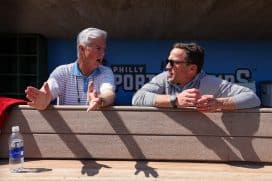Uncategorized
Medvedev has the stats, but not Hakstol’s trust
Since the Luke Schenn trade three weeks ago, the Philadelphia Flyers defense has finally found some stability. Where they previously had too many bodies to handle, Shayne Gostisbehere, Mark Streit, Nick Schultz, and Radko Gudas all have clearly established roles on the team. About the only remaining uncertainty on the blue line lies between Evgeny Medvedev and Brandon Manning.
Manning and Medvedev seem like two very different players. Manning is a young player, fighting for a permanent NHL job. He does a little bit of everything on the ice, including a willing fighter. Medvedev, on the other hand, is also trying to earn an NHL job, but is doing it at 33 years old.
Most Flyers fans presumably already know his story. A standout in the KHL and a mainstay in Russia's international lineup the last few years, Medvedev is finally trying his hand at the NHL. He clearly has NHL size, skating, and skill, but he's a stranger to the smaller NHL ice and the faster, physical game it allows.
The Flyers felt good enough about his abilities to sign him to a considerable contract this offseason, but the $3 million dollar question concerned his ability to adapt a different style of play. Regarding that issue, it was expected that it would take some time. Some cycling in and out the lineup early on was expected as he adjusted. Here we are, however, past the halfway point of the season, and those kinks in his game still pull him out of the lineup.
If it came down to pure stats, Medvedev easily beats of Manning. This chart shows the season stats for each player:
Medvedev has significantly better numbers down the line. The Flyers take more shots and concede fewer when Medvedev is on the ice. Medvedev has even contributed a decent number of goals and assists individually. In fact, only Gudas has a better Corsi percentage among all the defensemen on the team.
There's a particularly stark difference between Manning and Medvedev considering their performance with Ghost. Ghost has been a common partner for both Manning and Medvedev, but there's really no comparison to the possession results. When Medvedev combined with Gostisbehere as a third defensive pair, their Corsi percentage is essentially off the charts. Meanwhile, Manning's success with the dynamic Gostisbehere isn't in the same ballpark.
Something else is going on here to justify Manning and Medvedev splitting time. Manning may bring a little more aggression and physicality to the role, and can play a bit on the penalty kill, but that's not sufficient to explain it.
The most likely explanation is that Medvedev still has a tendency to struggle with a fast, physical forecheck. Sometimes you'll see him get checked and cough up the puck in his own zone, and other times you might see him rush more than he needs to and play the puck to a bad spot. Both plays are results of the same shortcoming; that Medvedev still plays like a rookie under pressure, regardless of his 33 years.
That his aggregate numbers are so good shows that his otherwise solid contributions eventually outweigh a few bad shifts or a bad period of "rookie" mistakes with the puck in his own zone. For Dave Hakstol and the Flyers coaches, that is cold comfort. Coaches like predictability. They can make game plans around predictable performances.
The combination of Medvedev's puck and skating skills, with his inconsistency under pressure,is illustrated by the amount of goals being scored when he is on the ice.
Only Ghost, with his high octane, youthful game is on the ice for more total goals being scored per minute. The effect is particularly dramatic when Medvedev and Gostisbehere are paired, and the total goals being scored goes through the roof. With either Medvedev or Manning, Gostisbehere is seeing 75 percent of goals scored when he is on the ice go the Flyers' way, but they're much more frequent with Medvedev.
It now appears Manning and Medvedev are not permanently connected to playing with Gostisbehere. In the Flyers last game before the All-Star break, Ghost played with Michael Del Zotto. We can only wait and see if that arrangement sticks. Whatever the pairings, the choice is clear. Medvedev hasn't adjusted to the NHL game as quickly as some in the Flyers' management may have hoped, so mistakes will be made and pucks will end up in the net.
Medvedev is only on a one-year contract. He is going to have to figure out the NHL game or Hakstol is going to have to trust the good outweighing the bad in the long term for Medvedev to receive more ice time and a new contract.
Furthermore, early in the season, I wondered if Medvedev could be a trade deadline asset to move. He has the skill set all NHL teams covet. His trade value, however, is significantly harmed by his slow adjustment to NHL forechecks. Many NHL coaches just aren't going to feel good about relying on an NHL rookie handling the puck under pressure in the playoffs.
The fans will like Medvedev's long-term statistical results, and certainly don't mind higher scoring action. Unfortunately coaches take a different view. Hopefully Medvedev can take another step forward in his NHL adjustment in the next month or so, and remove the last impediment to a clearly talented player languishing on the bench.
Marc Naples is a contributor to Flyerdelphia and Sports Talk Philly. Follow him on Twitter @SuperScrub47.












































